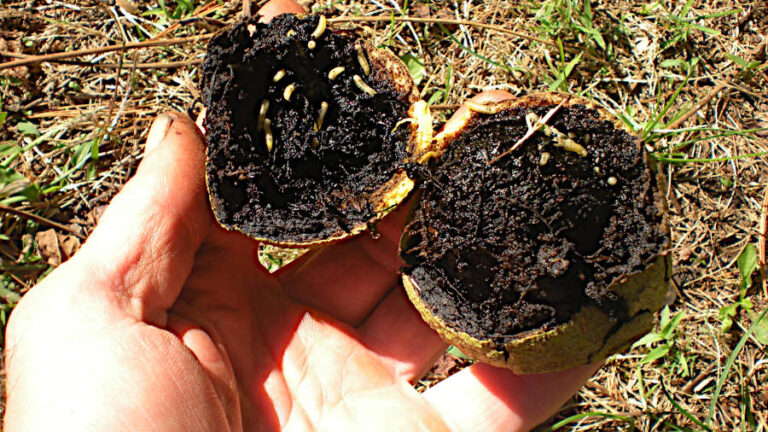A couple of years ago a lady neighbor who lives down a side road gave me bulbs to grow Egyptian Walking Onions, which are prolific perennial producers. The site I linked to includes many quality pictures (unlike mine), a brief description and history of these onions, and options to buy bulbs from an online catalogue. I found it interesting that some cats like to walk and patrol the onion patch. Or, maybe they just like the catnip offerings mixed among the onions. Probably both.
The animal- and plant-loving woman behind the website is Tracy Paine. Her personal website is StarSunMoon. Yes, it refers to astronomy. Yes, it refers to the Bible. And, yes, it refers to her cats.1Star, Sun, and Moon are the names of her cats. She operates a cat sanctuary and makes homemade cat food. She also sells custom metal pet-paws created from your favorite cat’s or dog’s paw print impression. Pretty cool.
She is even a poet and wrote an ode to The Egyptian Walking Onion!2 The poem is near the bottom of the main web page; she also shares an artificial intelligence (AI) generated poem that’s also good, but not great.
The Egyptian Walking Onion
Anyway, last spring I tossed a few bulbs in an outdoor flower pot and watered them as necessary. They easily survived the cold North Coast winter. So, this spring I replanted them in the main garden to give them the freedom they need to thrive. After all, these onions are (1) perennial and (2) “walking” – meaning they spread. Plus, I’ll be able to have a continual supply of onions by doing absolutely nothing but admiring their “walk,” since they are so durable there’s no need to water, or weed around, them – or replant them every spring.
Here they are less than two months after being replanted. And, they are thriving! They are now over four feet in height, at least double the height they were in the pot.
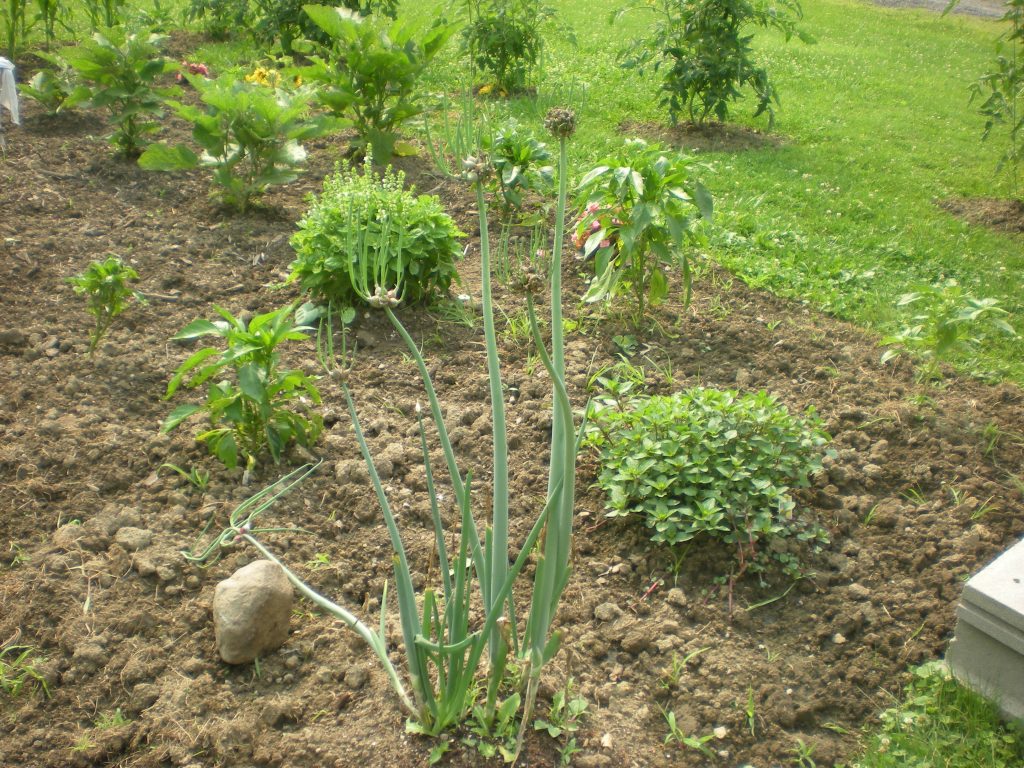
To the right is a new batch of peppermint (as if I don’t have enough; this one is extra peppery though), which is sending out its own spreaders. In the background you can see the pepper plants (they are still trying to recover from the deer and whistle pigs) and some eggplant, basil, corn, sunflower, begonia, and tomato plants. Also, some of these plants were bought in the spring from Wells Nursery, a local mom-and-pop “family run nursery in Kinsman (Vernon), Ohio since 1993. Plants Grown With Love.”
Nonetheless, I’ve kindly re-directed the one stalk that has begun to “walk” by using a rock since it was beginning to walk across my garden footpath. It will take root soon at that spot. The other stalks will follow in a similar manner shortly.
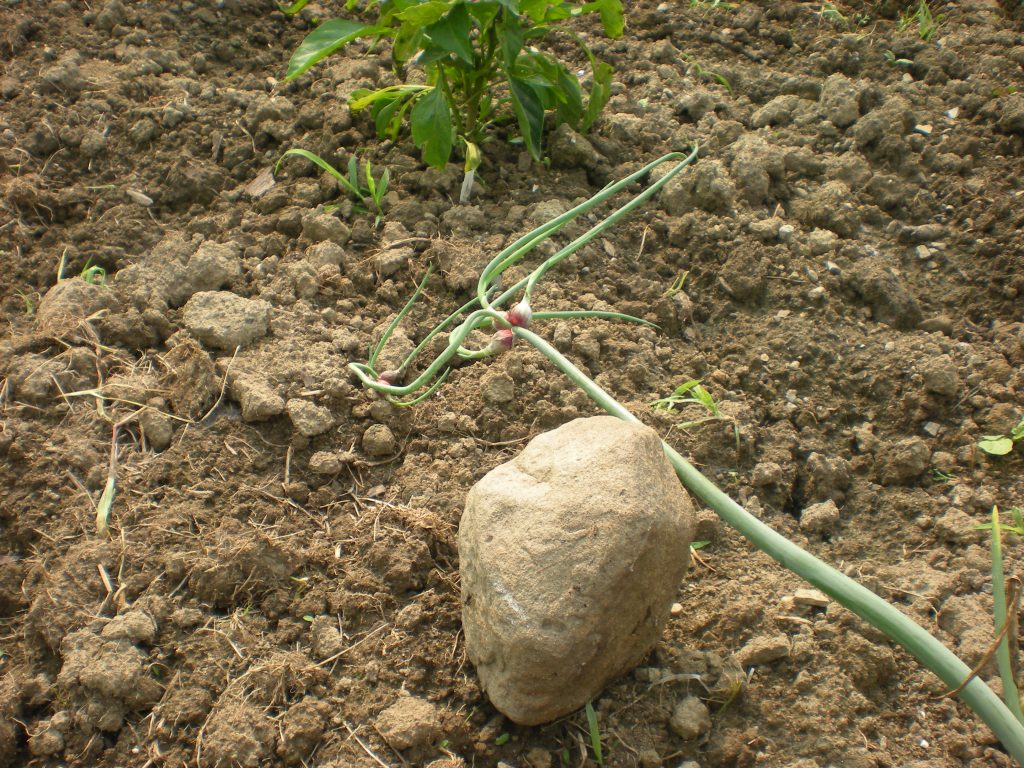
A Musical Interlude
At this point, one is probably thinking, “Hey, the Egyptian Walking Onions remind me of that 1986 song ‘Walk Like an Egyptian’ by the Bangles.” Well, one wouldn’t be wrong. The interesting thing about that hit song is that it was written by Akron, Ohio native Liam Sternberg.
“He [Liam] got the idea when he was on a ferry boat and saw people struggling to keep their balance. The way they held out their arms and jerked around made it look like they were doing Egyptian movements, and if the boat moved suddenly, they would all topple over.”
Songfacts
But, if one walks in my garden near dusk, a “happy dance” soundtrack wouldn’t be playing in one’s head.3I like this term and its context: it references a former-ish gal-pal-acquaintance’s describing a scenario by which someone asks her to essentially play happy dance music rather than music by Joy Division, whose music can be considered dark, dire, and droning – perhaps not unlike The Cure’s. It’s also a take on the “waggle dance” – a form of communication – of honey bees. Rather, The Cure’s “Hanging Garden” – or something similar – would likely come to mind.4This is actually the most uplifting song on The Cure’s Pornography album released in 1982. A song that evokes a drizzly, gloomy evening with general brooding on tap – and thoughts of the wild beasts that might be lurking in the brush (deer, whistle pigs, raccoon) and sky (hawks, ravens) just waiting to roam the garden’s footpaths at night and pillage and plunder the vegetable patch.
The Hanging Garden
The Hanging Garden Creatures kissing in the rain Shapeless in the dark again In the hanging garden please don't speak In the hanging garden no one sleeps (In the hanging garden) (In the hanging garden) Catching halos on the moon Gives my hands the shapes of angels In the heat of the night, the animals scream In the heat of the night, walking into a dream Fall fall fall fall Into the walls Jump, jump out of time Fall fall fall fall Out of the sky Cover my face as the animals cry In the hanging garden, in the hanging garden Creatures kissing in the rain Shapeless in the dark again In the hanging garden change the past In the hanging garden wearing furs and masks Fall fall fall fall Into the walls Jump, jump out of time Fall fall fall fall Out of the sky Cover my face as the animals die In the hanging garden As the animals die Cover my face as the animals die In the hanging garden
A Lazy Person’s Herb Garden
I “maintain” two circular herb gardens that are outside of the main rectangular tilled garden. In addition to the perennials I already mentioned, these are the others that partake in my perennial herb gardens:
- rosemary
- thyme
- oregano
- sage
- fennel
- lemon balm
- catnip
- mint (assorted)
Herb Garden One
One circle is adjacent to the main garden and separated by a circle of stones and rocks.
It doesn’t need weeding except to control the overpowering herbs (mints, Egyptians, etc.) from encroaching on the other herbs or flowers – or spreading into the main garden. The mint is considered invasive, but I embrace its nature – as it makes for a good ground/lawn covering like an English Ivy, and smells minty-fresh after mowing over it. This circle also doesn’t need watering since the perennials have deep roots and are durable – and my area has ample moisture and rain. The main garden, however, needs watered now-and-then, but not often.
In the first season, this circle was divided into sections planted with garlic, regular onions, mint, catnip, and nasturium (the edible flowers). They all grew, but I neglected it and allowed the catnip and mint to overwhelm everything, which they easily did. At this point, 90 percent of the patch is just mint. I removed most of the catnip – except a few stragglers – as I don’t like the taste or smell of catnip, which smells like marijuana.5 I’m told! I wouldn’t know this first hand, for the public record. The other 10 percent is onions – at least one is Egyptian (maybe they all are) as one can see how the stalk is beginning to lean and branch off. See the red arrows? That branch on the right will ultimately lower to the ground and take root a foot or two away from the base (that’s how it “walks”).
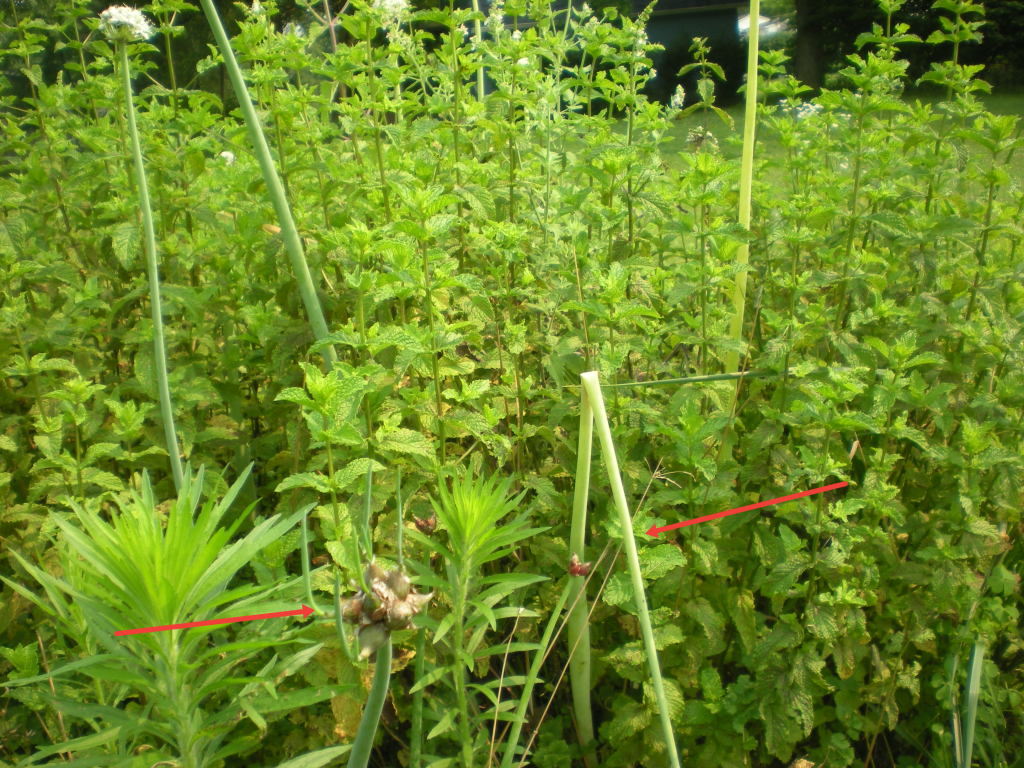
Of course, there is some wild growth mixed in, including dandelions, which I use for salad. Again, as a reminder, this is a lazy person’s herb garden. Why plant lettuce and such when one has a proliferation of delicious wild dandelions, one of the most nutrient-dense herbs available, popping-up just about everywhere? That’s like living up in the mountains and buying plastic bottled “spring” water when one has clean, natural mountain spring water flowing in one’s back yard. It doesn’t make sense, does it?
But, I’m beginning to go off topic a bit…
Herb Garden Two
The other herb garden is near my back door so it’s readily accessible for me to just step outside, pick a few fresh herbs, and toss on my meals. I used the ~3-foot diameter, half-foot deep wading pool as described that a neighbor gave me (he gave me two, actually).
All I did is poked holes in the bottom, filled with local soil and black gold (remnants of my compost bin). One could just as well buy a few bags of planting soil and manure (or worm castings) from one’s local garden center or hardware store. I also watched a video of some gardener (Jess of RootsAndRefuge Farm) doing this to learn tips and tricks. Also, a blog named The Spruce provides an instructables that goes into more detail, but I did what made sense for my circumstance.
For someone even lazier than I am, one could put a kid’s pool on a deck or back porch, since it’s really no different than planting in a flower pot – except it’s easier and more productive. The pool, as mentioned, would just need drainage holes – so a deck would work well since most decks enable water to drain through or off of them.
Interestingly, since I left the fennel to go to seed last year, they have spread all over the nearby area, so I now have “wild” fennel growing all over the place in abundance. The fennel is in the center of the pool; the tops reach at least 7-feet high. You can see the wild ones growing outside of the pool in the right and left foregrounds. By the way, I save the fennel seeds to use on meals or to use as an after dinner breath freshener and digestive aid (like they give at authentic Indian restaurants at the the check-out counter).
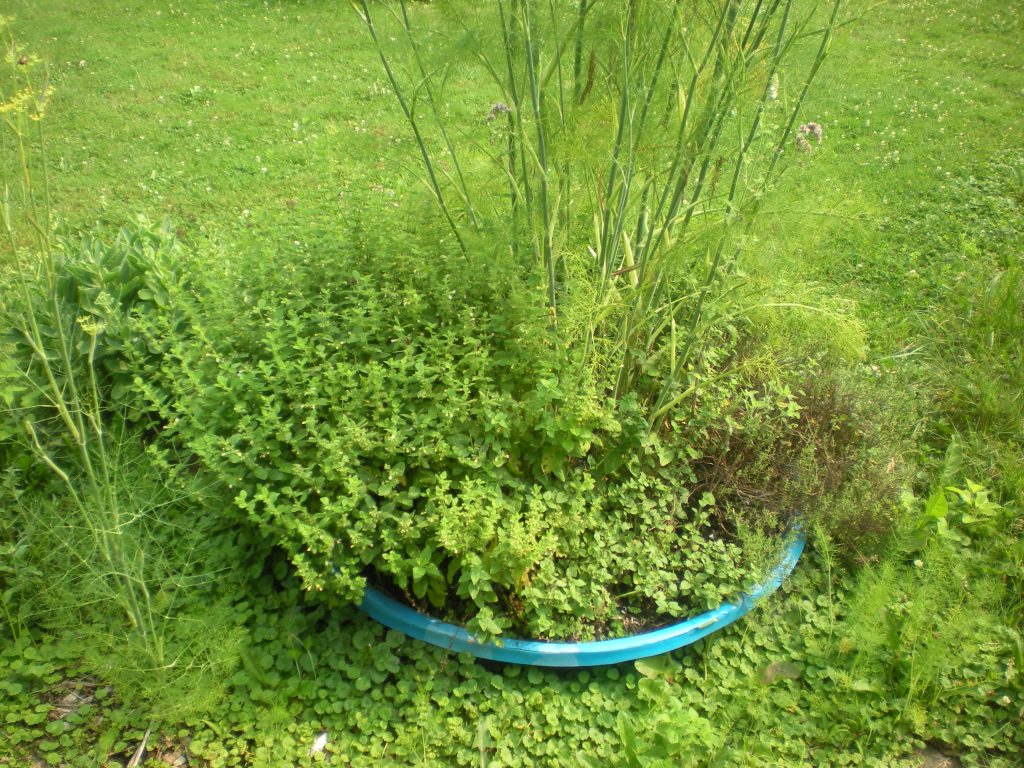
Wading Pool – Made in USA
These wading pools are just over three feet in diameter and about half-a-foot deep (inner dimensions).
The brand is “Summer Escapes” made by General Foam Plastics Corp. out of Norfolk, VA. Sadly, the company’s website, GenFoam.com, has a message from the CEO stating that the company closed its doors at year-end 2017.

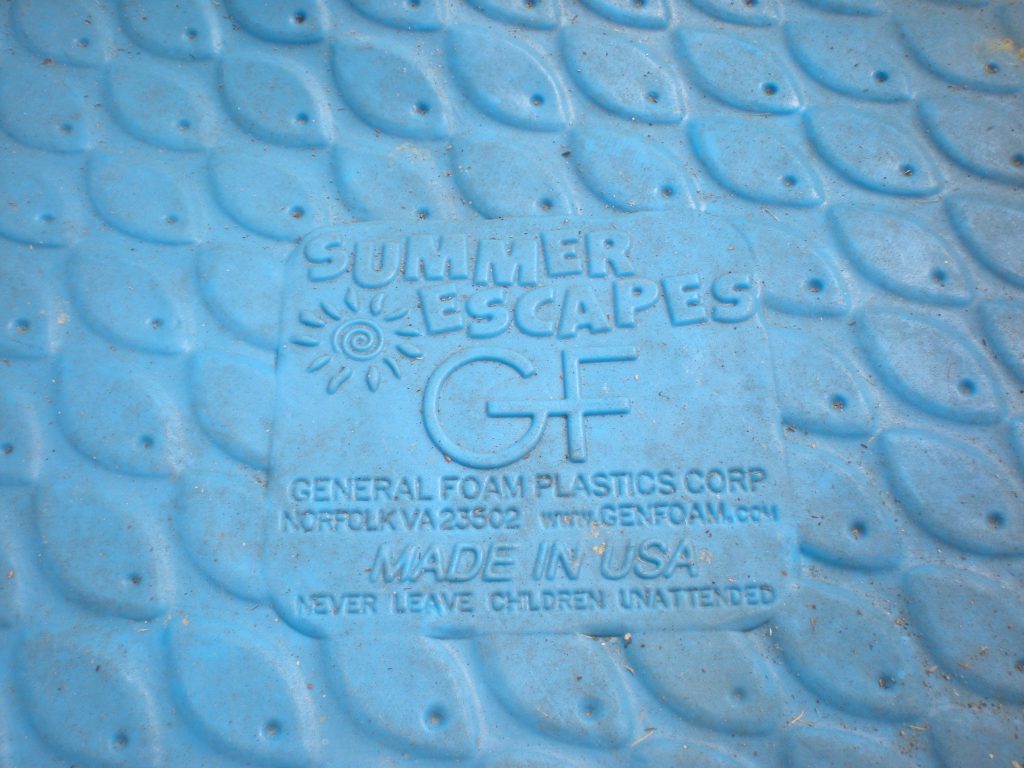
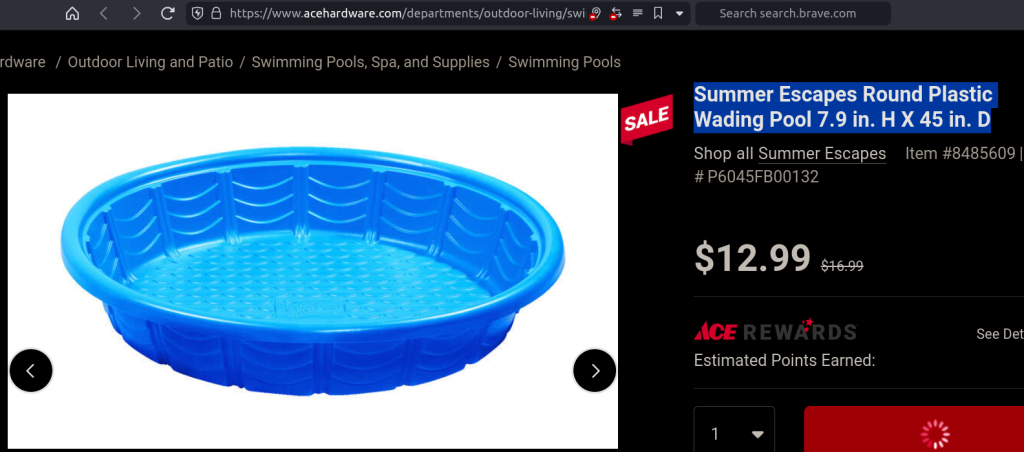
Nevertheless, I did a quick Internet search and found that the item and brand are still sold by many vendors including Ace Hardware, which is a local option for me (I already have two, though – one in use as described and the other pictured above). Ace lists the pool at $12.99 and describes it as such: “Summer Escapes Round Plastic Wading Pool 7.9 in. H X 45 in. D.” [These are outer dimensions.]
Closing Words
What is your experience growing perennial herbs? What do-it-yourself (DIY) ideas do you have to share related to growing herbs and vegetables? Let the dozen or so loyal readers and me know in the comments.
Footnotes
- 1Star, Sun, and Moon are the names of her cats. She operates a cat sanctuary and makes homemade cat food.
- 2The poem is near the bottom of the main web page; she also shares an artificial intelligence (AI) generated poem that’s also good, but not great.
- 3I like this term and its context: it references a former-ish gal-pal-acquaintance’s describing a scenario by which someone asks her to essentially play happy dance music rather than music by Joy Division, whose music can be considered dark, dire, and droning – perhaps not unlike The Cure’s. It’s also a take on the “waggle dance” – a form of communication – of honey bees.
- 4This is actually the most uplifting song on The Cure’s Pornography album released in 1982.
- 5I’m told! I wouldn’t know this first hand, for the public record.

